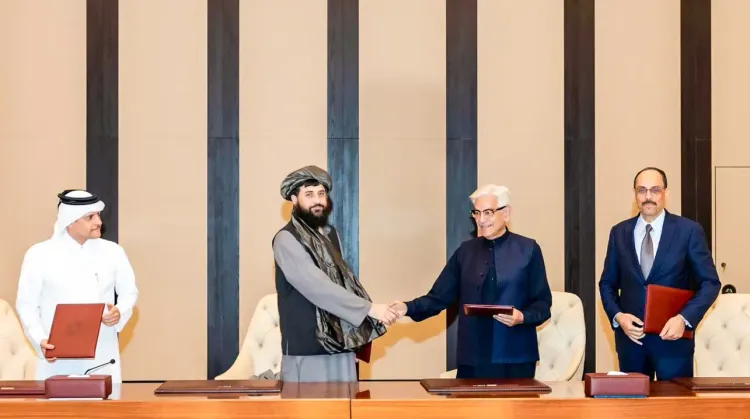Has the Pak-Afghan Confrontation Ended Islamabad’s ‘Strategic Depth’ Fantasy?

Synopsis
Key Takeaways
- Pakistan's strategy of using proxies has failed.
- The Taliban's growing autonomy poses a challenge to Islamabad.
- Regional dynamics are shifting with India gaining diplomatic ground.
- The confrontation highlights the limitations of military diplomacy.
- Pakistan must recognize Afghanistan's sovereignty and interests.
New Delhi, Oct 24 (NationPress) Four years ago, when the last American military planes departed from Bagram Air Base, the generals in Pakistan celebrated with unrestrained enthusiasm.
The Taliban’s victorious return to Kabul was viewed in Rawalpindi as a validation of Pakistan’s long-standing regional strategy aimed at fostering a perceived “strategic depth”. This strategy was intended to provide decisive influence and establish a compliant Islamist buffer state against India.
However, the situation has dramatically changed, revealing the fragility of that illusion. The recent, violent clashes across the border between Pakistani and Taliban forces signify not only a collapse of the post-2021 “Taliban-ISI detente” but also a major shift in Pakistan’s regional dynamics.
What initially started as a calculated proxy strategy has now escalated into outright conflict. The Pakistani military, once the supporter and benefactor of the Afghan Taliban, is now engaged in direct combat with its former allies.
On October 11, fierce fighting erupted along the Durand Line, extending from Chitral to Angoor Adda in Khyber Pakhtunkhwa and Bahram Chah in Balochistan, involving the Pakistani Army and Afghan Taliban forces.
Pakistan utilized advanced fighter jets and artillery against the Taliban positions, claiming over 200 casualties among their ranks, in addition to losses among Pakistan Taliban fighters.
Conversely, Kabul asserts that 58 Pakistani soldiers were killed, while the Inter-Services Public Relations (ISPR) of Pakistan acknowledged 23 soldiers lost. The clashes persisted until urgent mediation was provided by Saudi Arabia and Qatar, emphasizing the seriousness of a conflict that could escalate into a full-blown border war.
This episode of military confrontation is not merely a border skirmish; it represents a significant failure of Pakistan’s regional strategy, which has long depended on the dangerous notion that militant proxies can be effectively managed. The belief that ideological ties can substitute for sovereignty and that regional dominance can be maintained through coercion has now been fundamentally challenged.
It is well-known how Pakistan’s military establishment invested significantly in the Afghan Taliban’s resurgence, operating under the belief that it could influence Kabul’s decisions to align with its regional interests.
Throughout the two decades of the U.S.-led conflict in Afghanistan, the Inter-Services Intelligence (ISI) meticulously nurtured Taliban networks in Pakistan’s border regions, providing sanctuary to senior leaders while benefiting from billions in U.S. counterterrorism aid.
This duplicity was tolerated by Washington as long as Pakistan appeared to cooperate against Al-Qaeda. However, with the U.S. withdrawal, the contradictions of this relationship have resurfaced. Once in power, the Afghan Taliban no longer relied on Pakistan and sought to assert their independence. As Kabul began to pursue its own foreign policy, seeking recognition from powers like Iran, China, Russia, and India, tensions with Pakistan escalated.
For Islamabad, this newfound autonomy is unacceptable. The Pakistani establishment’s entire regional strategy was predicated on the belief that Afghanistan would remain strategically subordinate—a convenient buffer for projecting influence and curbing adversaries, particularly India.
However, the Taliban administration has consistently defied Pakistani directives, especially regarding the Tehreek-e-Taliban Pakistan (TTP), the insurgent group Islamabad claims operates from Afghan territory. The Taliban’s refusal to restrict TTP activities or extradite its leaders has become a significant source of tension.
Pakistan’s airstrikes on October 9, reportedly targeting TTP leader Noor Wali Mehsud, were not merely tactical responses but indicative of strategic frustration, particularly after suffering numerous military casualties, including 12 the day prior, during anti-insurgency operations.
The strikes targeted locations in Kabul, Khost, Paktia, and Paktika, signaling a readiness to escalate conflict not only with the militant group but also against the Afghan state.
However, these actions also showcase the limitations of Pakistan’s militarized approach to regional diplomacy. After decades of relying on coercion and proxies, Pakistan seems unable to engage its neighbors through diplomatic or economic means. Consequently, when influence wanes, the instinct is to resort to military action.
The outcome is a region increasingly marked by hostility. The Taliban’s Afghanistan is now as defiant as India and Iran, once perceived by Islamabad as primary adversaries. Pakistan’s aggressive tactics have left it isolated within a neighborhood where nearly every actor questions its credibility.
For New Delhi, the events unfolding along the Durand Line serve as a quiet yet profound validation. Indian policymakers have long warned that Pakistan’s strategy of fostering militant groups would ultimately backfire. This prophecy has now come to pass: the very proxies Islamabad once relied upon for leverage have turned against it, threatening Pakistan’s own security and sovereignty.
The surge of TTP attacks within Pakistan and Islamabad’s failure to control them bolster India’s argument that utilizing extremist proxies is inherently self-defeating. This also strengthens New Delhi’s position on the international stage, particularly among Western nations, that Islamabad remains both a perpetrator and a victim of terrorism, having relied on arbitrary distinctions between “good” and “bad” Taliban.
The Taliban’s increasing autonomy provides New Delhi with a rare diplomatic opportunity. In an almost unimaginable move just a few years ago, the Taliban’s foreign minister, Amir Khan Muttaqi, made his inaugural official visit to India this month, coinciding with Pakistan's airstrikes and subsequent border clashes. The timing was telling as Islamabad bombed Afghan territory while Kabul sought engagement with India.
Muttaqi’s visit highlighted a convergence of interests between Kabul and New Delhi. The Taliban has openly endorsed India’s involvement in the Chabahar port project in Iran as a potential trade route for Afghanistan, reducing reliance on Pakistan’s ports. For India, this represents a subtle but significant strategic advantage, undermining Pakistan’s longstanding ambition to dominate Afghanistan’s trade routes and geopolitical orientation.
Moreover, the military confrontations and Kabul’s diplomatic shifts symbolize the effective demise of Pakistan’s “strategic depth” doctrine, which envisioned Afghanistan as a compliant backyard for its regional objectives. Islamabad and Rawalpindi must now confront the reality they have long denied: Afghanistan, as a sovereign state, will pursue its own interests, even when they conflict with those of Pakistan.
This overreach threatens to further diminish the military’s credibility. Pakistanis are increasingly questioning the army’s failure to deliver basic security, as it controls both federal governance and the country’s foreign policy. Internationally, these actions reinforce the perception of a state perpetually at odds with its neighbors and as a security actor rather than a reliable partner.
What stands out is the collapse of Pakistan’s efforts to manipulate the regional landscape through militant leverage. While the Taliban’s Islamic Emirate asserts its independence, India is gradually re-establishing its presence in Afghanistan through discreet diplomacy and development-focused engagement. Even China and Iran, although cautious, prefer direct dealings with Kabul rather than through Islamabad’s military mediation.
In this evolving context, India’s restraint appears increasingly strategic. By maintaining engagement and signaling openness to dialogue, New Delhi gains diplomatic leverage without becoming entangled. If Pakistan’s recent strikes aimed to reassert dominance, the advantage now lies with India, as Kabul perceives through Islamabad’s façade and moves closer to New Delhi.










